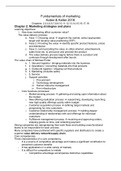Samenvatting
Samenvatting A Framework for Marketing Management, Global Edition, ISBN: 9781292093147 Fundamentals of marketing
- Instelling
- Nyenrode Business Universiteit (Nyenrode)
Dit document bevat een samenvatting voor het boek 'A framework for marketing management.' De editie is 2016 en het boek is geschreven door Kotler en Keller. De samenvatting bevat de hoofdstukken 2 t/m 18. Het is een gedetailleerde samenvatting.
[Meer zien]





